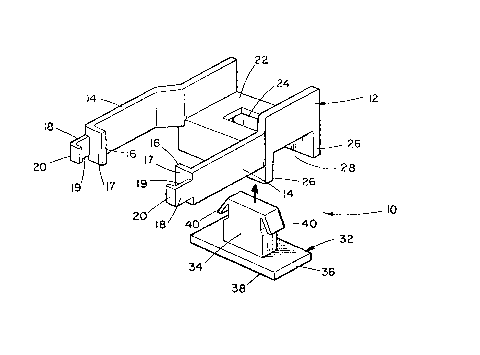Une partie des informations de ce site Web a été fournie par des sources externes. Le gouvernement du Canada n'assume aucune responsabilité concernant la précision, l'actualité ou la fiabilité des informations fournies par les sources externes. Les utilisateurs qui désirent employer cette information devraient consulter directement la source des informations. Le contenu fourni par les sources externes n'est pas assujetti aux exigences sur les langues officielles, la protection des renseignements personnels et l'accessibilité.
L'apparition de différences dans le texte et l'image des Revendications et de l'Abrégé dépend du moment auquel le document est publié. Les textes des Revendications et de l'Abrégé sont affichés :
| (12) Brevet: | (11) CA 1262289 |
|---|---|
| (21) Numéro de la demande: | 1262289 |
| (54) Titre français: | OUTIL D'INSERTION/EXTRACTION DE CIRCUIT INTEGRE |
| (54) Titre anglais: | IC INSERTION/EXTRACTION TOOL |
| Statut: | Périmé et au-delà du délai pour l’annulation |
| (51) Classification internationale des brevets (CIB): |
|
|---|---|
| (72) Inventeurs : |
|
| (73) Titulaires : |
|
| (71) Demandeurs : |
|
| (74) Agent: | KIRBY EADES GALE BAKER |
| (74) Co-agent: | |
| (45) Délivré: | 1989-10-10 |
| (22) Date de dépôt: | 1987-07-30 |
| Licence disponible: | S.O. |
| Cédé au domaine public: | S.O. |
| (25) Langue des documents déposés: | Anglais |
| Traité de coopération en matière de brevets (PCT): | Non |
|---|
| (30) Données de priorité de la demande: | ||||||
|---|---|---|---|---|---|---|
|
ABSTRACT OF THE DISCLOSURE
A tool for insertion and extraction of a packaged
IC to and from a socket includes a pair of flexible,
parallel arms joined at two ends by a "U" shaped portion.
The free ends of the two arms when moved towards each other
are adapted to grip the IC at opposite ends and allow a
rocking motion to be applied to loosen the pins of the IC
within the socket and then for a lifting force to be applied
to remove the IC from the socket, all with minimum distortion of
the pins. A plunger having a base which is positioned and is
free to move between the two parallel walls within the "U" is
used to insert an IC into its socket. The IC is positioned
between the two walls of the "U" with the pins of the IC
pointing outwards and the surface opposite the pins in contact
with the base of the plunger. The IC is retained within the
"U" by a predetermined interference fit between the walls and
the IC. The tool positions the IC over the socket and a
downward force is applied to the plunger to push the IC out of
the "U" portion and into the socket.
Note : Les revendications sont présentées dans la langue officielle dans laquelle elles ont été soumises.
Note : Les descriptions sont présentées dans la langue officielle dans laquelle elles ont été soumises.

2024-08-01 : Dans le cadre de la transition vers les Brevets de nouvelle génération (BNG), la base de données sur les brevets canadiens (BDBC) contient désormais un Historique d'événement plus détaillé, qui reproduit le Journal des événements de notre nouvelle solution interne.
Veuillez noter que les événements débutant par « Inactive : » se réfèrent à des événements qui ne sont plus utilisés dans notre nouvelle solution interne.
Pour une meilleure compréhension de l'état de la demande ou brevet qui figure sur cette page, la rubrique Mise en garde , et les descriptions de Brevet , Historique d'événement , Taxes périodiques et Historique des paiements devraient être consultées.
| Description | Date |
|---|---|
| Inactive : CIB de MCD | 2006-03-11 |
| Le délai pour l'annulation est expiré | 2004-10-12 |
| Lettre envoyée | 2003-10-10 |
| Accordé par délivrance | 1989-10-10 |
Il n'y a pas d'historique d'abandonnement
| Type de taxes | Anniversaire | Échéance | Date payée |
|---|---|---|---|
| Annulation de la péremption réputée | 2002-10-10 | 1997-08-27 | |
| TM (catégorie 1, 8e anniv.) - petite | 1997-10-10 | 1997-08-27 | |
| Annulation de la péremption réputée | 2002-10-10 | 1998-09-24 | |
| TM (catégorie 1, 9e anniv.) - petite | 1998-10-13 | 1998-09-24 | |
| TM (catégorie 1, 10e anniv.) - petite | 1999-10-11 | 1999-09-20 | |
| Annulation de la péremption réputée | 2002-10-10 | 1999-09-20 | |
| TM (catégorie 1, 11e anniv.) - petite | 2000-10-10 | 2000-09-15 | |
| Annulation de la péremption réputée | 2002-10-10 | 2000-09-15 | |
| Annulation de la péremption réputée | 2002-10-10 | 2001-09-20 | |
| TM (catégorie 1, 12e anniv.) - petite | 2001-10-10 | 2001-09-20 | |
| Annulation de la péremption réputée | 2002-10-10 | 2002-09-19 | |
| TM (catégorie 1, 13e anniv.) - petite | 2002-10-10 | 2002-09-19 |
Les titulaires actuels et antérieures au dossier sont affichés en ordre alphabétique.
| Titulaires actuels au dossier |
|---|
| AMERICAN TELEPHONE & TELEGRAPH COMPANY |
| Titulaires antérieures au dossier |
|---|
| JOSEPH G. MURGLIN |
| ROBERT L. CARLSON |